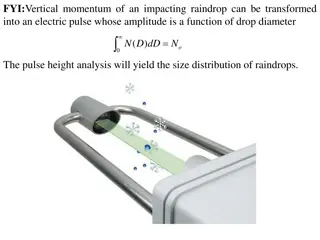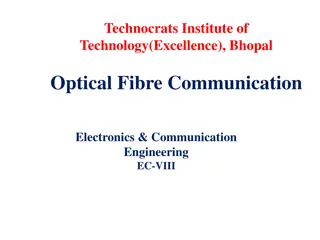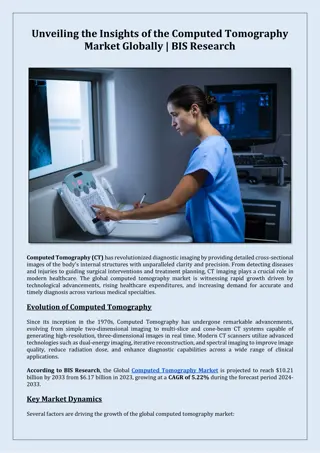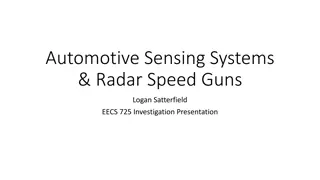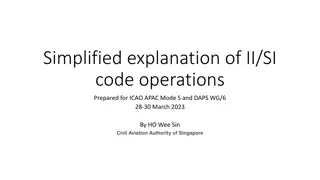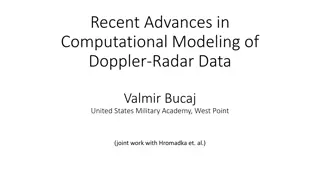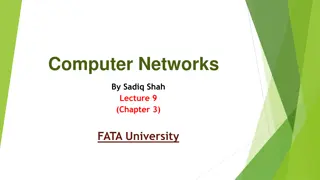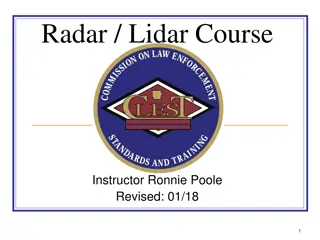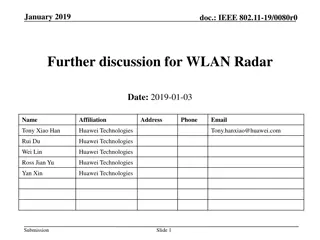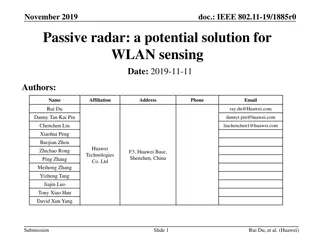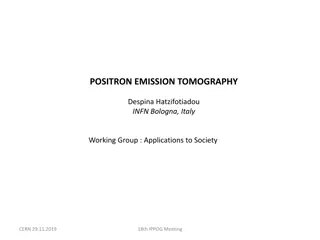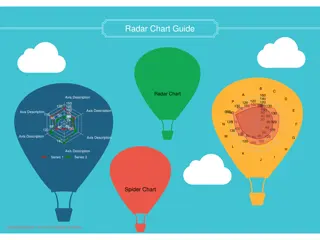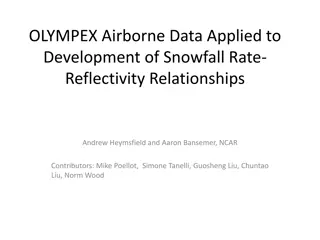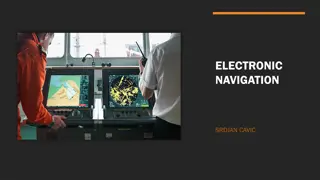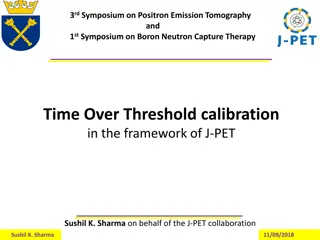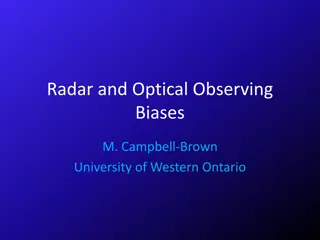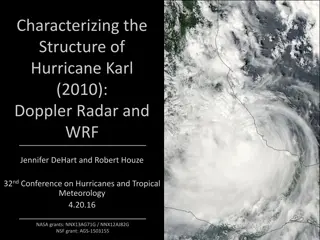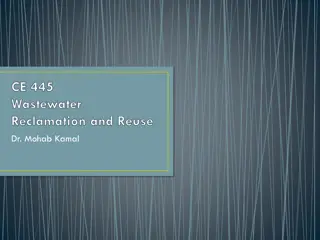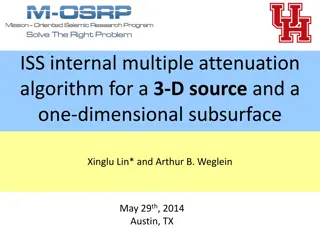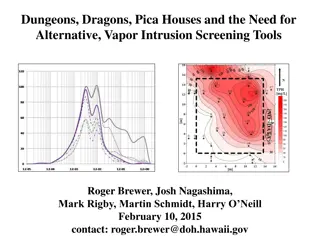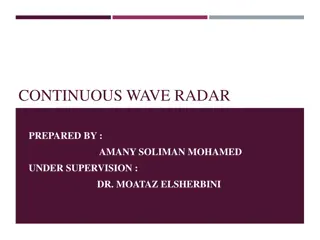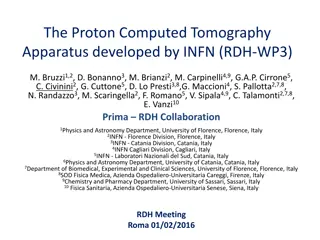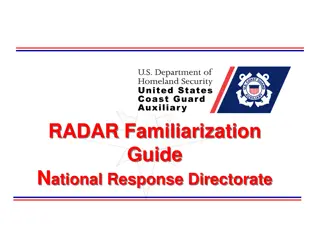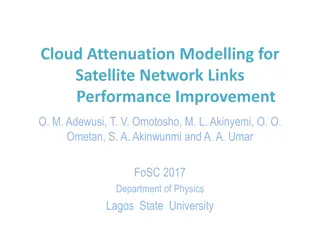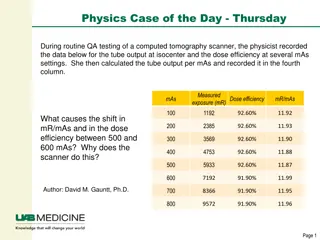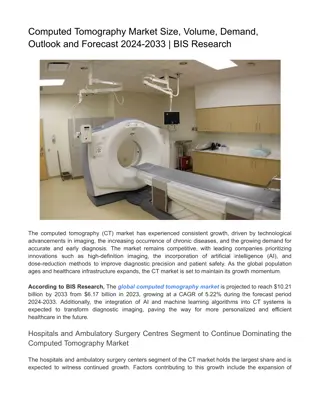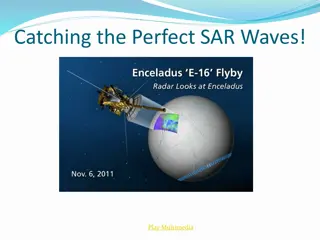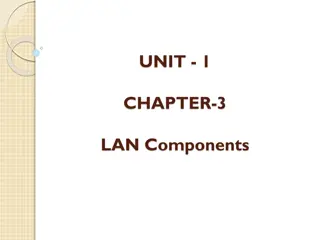Neural quantum state tomography, improvements and applications
Advancements and potential applications of neural quantum state tomography, aiming to reduce the exponential classical memory required for expressing quantum states. It discusses the benefits of using machine learning techniques to process and analyze quantum data, such as cleaning up states, manipu
4 views • 26 slides
Radar Attenuation Tomography for Mapping Englacial Temperature Distributions
Radar Attenuation Tomography is used to map the temperature distributions within the ice sheet by analyzing the radio waves' attenuation properties. This study focuses on the Eastern Shear Margin of Thwaites Glacier, where fast-moving ice meets slower ice, impacting ice rheology influenced by temper
4 views • 18 slides
Phased Array Antenna Design for Smart Intersection Radar Using Analog Devices ADAR-1000
Designing a phased array antenna system for a smart intersection radar project utilizing the Analog Devices ADAR-1000 beamformer. The system involves 4 independent phased arrays covering key directions in the intersection, with considerations for beam steering, beamwidth, and array configuration. Ke
0 views • 9 slides
Advancing Radar Science: Open-Source Collaboration for Precipitation Estimation
Explore the innovative work presented at the Open Radar Science in SAIL conference featuring collaborative research, open-source tools like Py-ART and Xradar, and value-added products enhancing quantitative precipitation estimates. Learn about CMAC, SQUIRE, and other techniques for radar data proces
2 views • 10 slides
Insights into Raindrop Size Distribution and Precipitation Intensity through Radar Technology
Vertical momentum of impacting raindrops can be converted into an electric pulse to analyze raindrop size distribution. Disdrometers using video cameras can directly count raindrops for sizing. Radar technology provides superior data on precipitation accumulation and intensity by measuring radar ref
4 views • 9 slides
BTH/OTH Radar and Maritime Surveillance Radar Overview
The article discusses BTH/OTH radar systems and maritime surveillance radars, exploring their functionalities, benefits, drawbacks, and real-world examples. It delves into the working principles of OTH radar, showcasing how it operates through the ionosphere. Additionally, it covers the concept of m
5 views • 12 slides
Understanding Optical Fiber Signal Degradation in Communication Engineering
Technocrats Institute of Technology (Excellence) in Bhopal delves into the concepts of signal degradation in optical fiber communication, focusing on attenuation, distortion mechanisms, and measurement techniques. The institute emphasizes the importance of signal attenuation and its impact on inform
4 views • 56 slides
Unveiling the Insights of the Computed Tomography Market Globally | BIS Research
According to BIS Research, the Global Computed Tomography Market is projected to reach $10.21 billion by 2033 from $6.17 billion in 2023, growing at a CAGR of 5.22% during the forecast period 2024-2033.
2 views • 3 slides
Drone Detection Using mmWave Radar for Effective Surveillance
Utilizing mmWave radar technology for drone detection offers solutions to concerns such as surveillance, drug smuggling, hostile intent, and invasion of privacy. The compact and cost-effective mmWave radar systems enable efficient detection and classification of drones, including those with minimal
0 views • 8 slides
Automotive Sensing Systems & Radar Technology Overview
Explore the world of automotive sensing systems and radar technology including radar speed guns. Learn about the sensors used in cars for various applications such as radar cruise control, collision detection, and more. Discover the characteristics of these sensors and how they can be augmented or r
0 views • 7 slides
Understanding Mode-S Radar Operations and Identifiers
This simplified explanation delves into the fundamental principles of radar operations, focusing on Primary and Secondary radar systems, including Mode A/C and Mode S functionalities. It covers radar interrogation, replies, and the significance of radar identifiers (II and SI codes) in managing over
0 views • 19 slides
Recent Advances in Computational Doppler Radar Data Modeling
Explore the latest developments in computational modeling of Doppler radar data, focusing on error estimation, dual vs. single pol radars comparison, uncertainty quantification, and methodology for analyzing Doppler radar predictions against gauge measurements. The study involves data from multiple
0 views • 40 slides
Understanding Transmission Impairments in Computer Networks
Signals traveling through transmission media in computer networks can experience attenuation, distortion, and noise, leading to signal loss and changes in form or shape. Attenuation results in energy loss requiring amplification, while distortion alters the signal's composition. Engineers use decibe
1 views • 12 slides
Radar and Lidar Course Legal Requirements in Arkansas
This content provides information on the legal considerations, training requirements, and regulations for radar and lidar operators in Arkansas, as well as the criteria for CLEST certification. It covers statutes related to operator qualifications, speed trap laws, and the issuance of operator certi
0 views • 187 slides
Radar Function Integration in WLAN: January 2019 Discussion
The January 2019 document IEEE 802.11-19/0080r0 explores integrating radar functions into WLAN to enhance coexistence. The proposal outlines various options, including modified schemes and dedicated indication methods for radar operation within WLAN frameworks. It emphasizes the need for feedback on
3 views • 12 slides
Passive Radar for WLAN Sensing in Indoor Scenarios
Radar and CSI have been proposed as potential WLAN sensing techniques. This document focuses on passive radar at 5 GHz in indoor scenarios, discussing background, experimental results, signal processing techniques, and potential impacts on WLAN standards.
6 views • 15 slides
WLAN-Based Radars in the 60GHz Band Using IEEE 802.11-19/1854r0 Protocol
Utilizing IEEE 802.11ad/11ay devices, this presentation demonstrates how radar applications can be implemented with minimal hardware modifications, showcasing enhanced radar information accuracy through device collaboration. The advantages of the 60GHz band for short-range radar applications, such a
0 views • 14 slides
Positron Emission Tomography: Applications in Society and Recent Developments
Positron Emission Tomography (PET) is a medical imaging technique focusing on metabolic differences in the body. By using positron-emitting radioisotopes, PET can detect how molecules are taken up by healthy and cancerous cells, aiding in accurate tumor localization with lower doses. The evolution o
0 views • 6 slides
Value Optimization Through Diamond Tomography: Executed Solutions and Alternate Plans
This presentation explores the process of optimizing value through diamond tomography, showcasing rough diamond samples, executed solutions, and alternate plans. Detailed analysis of diamond characteristics and gains achieved, along with visual representations of proposed strategies and implemented
0 views • 6 slides
Complete Guide to Radar Charts: Benefits, Drawbacks, and Tips
Radar charts, also known as spider charts, offer a graphical way to compare data in a web-like form, making it easy to evaluate multiple alternatives based on various criteria. While radar charts have benefits like highlighting strengths and deficiencies clearly, they also come with drawbacks such a
0 views • 12 slides
OLYMPEX Airborne Data Analysis for Snowfall Rate-Reflectivity Relationships
Utilizing Citation aircraft data from OLYMPEX, this study focuses on developing relationships between snowfall (rainfall) rate and radar reflectivity across various radar bands. Comparisons are made between in-situ aircraft data and retrieval products from CloudSat, GPM, and TRMM datasets. Results i
0 views • 12 slides
Exploring Electronic Navigation Technologies
Electronic navigation technologies, such as satellite navigation, radio navigation, and radar navigation, utilize electricity-powered systems for precise positioning and tracking. Satellite navigation systems rely on signals from satellites for autonomous geo-spatial positioning, while radio navigat
0 views • 9 slides
Proposal of TG3d Channel Model for Wireless Backhaul/Fronthaul in IEEE 802.15 Working Group
This document presents a proposal for a TG3d channel model intended for wireless backhaul/fronthaul applications within the IEEE 802.15 Working Group. The proposal addresses operational characteristics, including high path loss mitigation at 300 GHz, requiring high gain antennas for LOS connections.
0 views • 20 slides
Symposium on Positron Emission Tomography and Boron Neutron Capture Therapy Time-Over-Threshold Calibration in J-PET
The 3rd Symposium on Positron Emission Tomography and 1st Symposium on Boron Neutron Capture Therapy focused on Time-Over-Threshold calibration within the framework of J-PET. The event outlined experimental details, event selection, results, and key features of the Jagiellonian Positron Emission Tom
0 views • 35 slides
Understanding Radar and Optical Observing Biases in Meteor Detection
Exploring radar and optical observing biases in meteor detection, this content delves into factors affecting mass detection, ionization efficiency, transverse radar effects, and more. Gain insights into how radar technology plays a crucial role in determining meteor properties and overcoming observa
1 views • 13 slides
Analyzing Hurricane Karl (2010): Doppler Radar Insights
Detailed analysis of Hurricane Karl (2010) using Doppler radar and WRF simulations, focusing on precipitation patterns over Mexican terrain and underlying processes. Includes NASA and NOAA grants, airborne radar measurements, WRF simulations, flight tracks, and velocity distributions comparison betw
0 views • 19 slides
Prediction of Liver Fibrosis in NAFLD Patients: Impact of CAP Values
Steatosis has emerged as a significant diagnosis with NAFLD becoming a common cause for hepatologic evaluation. Liver stiffness measurement (LSM) using transient elastography is vital for assessing fibrosis severity in NAFLD patients. However, the accuracy of LSM can be influenced by obesity and sev
0 views • 35 slides
Design Principles for Water Reclamation and Reuse
Achieving consistent reclaimed water quality requires proper treatment strategies, technical controls, online monitoring, and operational controls. The design principles focus on elements like monitoring, attenuation, retention, and blending to ensure water quality for various reuse applications. Wa
0 views • 22 slides
Enhanced Algorithm for Internal Multiple Attenuation in Seismic Imaging
This research discusses the development of an improved algorithm for internal multiple attenuation in seismic imaging. The focus is on addressing the challenges in onshore and offshore regions close to a 1-D earth model. The algorithm aims to enhance the efficiency and accuracy of data processing in
0 views • 61 slides
Alternative Vapor Intrusion Screening Tools for Environmental Investigations
Estimation of subslab attenuation factors for vapor intrusion investigations is crucial in assessing indoor air quality. This study reviews EPA methods, emphasizing the importance of vapor attenuation in screening indoor air for contaminants. Various experts contributed insights, leading to the deve
0 views • 35 slides
Continuous Wave Radar Systems Overview
This presentation discusses Continuous Wave radar systems, including types of radar such as CW and FM-CW systems, as well as advantages and disadvantages of CW radar. It covers topics like CW radar operation, receiver technologies, and the Doppler effect in CW radar. The content provides a comprehen
0 views • 10 slides
Development of Proton Computed Tomography Apparatus by INFN (RDH-WP3)
The Proton Computed Tomography Apparatus, developed by the INFN (RDH-WP3) collaboration, consists of two pCT systems for high-energy tomography. Various tests and analyses have been conducted, with plans for further testing in 2016. The system utilizes Algebraic Reconstruction Techniques and silicon
0 views • 36 slides
Radar Familiarization Guide for Surface Operations: Understanding How Radar Works
This radar familiarization guide by the National Response Directorate provides important information on the proper use of radar equipment, including its basic principles, functions, and practical applications for surface operations. It emphasizes the significance of radar in ensuring safe navigation
0 views • 47 slides
Enhancing Satellite Network Links Performance through Cloud Attenuation Modelling
This paper discusses the impact of cloud attenuation on satellite network links in tropical regions like southwest Nigeria with high cloud cover percentages. The study focuses on improving satellite communication system design and operation by analyzing cloud effects and proposing modelling techniqu
1 views • 39 slides
Understanding Dose Efficiency in Computed Tomography Imaging
The physicist conducted testing on a computed tomography scanner to analyze the tube output and dose efficiency at various mAs settings. The shift in dose efficiency between 500 and 600 mAs is due to the use of different focal spots and collimator adjustments. When the collimator accommodates the la
0 views • 6 slides
Computed Tomography Market Demand, Outlook and Forecast 2024-2033 | BIS Research
The global computed tomography market is projected to reach $10.21 billion by 2033 from $6.17 billion in 2023, growing at a CAGR of 5.22% during the forecast period 2024-2033.\n\nRead Report Overview: \/\/bisresearch.com\/industry-report\/computed-to
1 views • 3 slides
Understanding Electromagnetic Waves and Radar Systems
Dive into the world of electromagnetic waves and radar systems with detailed explanations on wave basics, the electromagnetic spectrum, radar technology, and applications in geometry. Discover how radio waves are used in radar systems and the importance of electromagnetic energy in modern engineerin
0 views • 13 slides
LAN Hardware Components and Connectivity Mediums
LAN hardware components, such as cables, repeaters, hubs, switches, and network interface cards, play a crucial role in transmitting electric signals between devices. Cables are the primary connectivity medium, with factors like bandwidth and distance affecting data transmission. External disturbanc
0 views • 26 slides
Human Activity Recognition from Millimeter-Wave Radar Point Clouds
Accurate human activity recognition (HAR) is crucial for context-aware applications. This study presents a framework utilizing mmWave radar-generated point clouds for HAR, addressing challenges related to privacy and sensors. Different machine learning approaches were evaluated, and a new open-sourc
0 views • 11 slides
Tracking and Identifying People with Millimeter Wave Radar
This study presents a human tracking and identification system using mmWave radar technology, offering high precision and the ability to conceal behind materials. The system achieved a median tracking accuracy of 0.16m and an identification accuracy of 89% for 12 individuals. Unlike traditional meth
0 views • 12 slides




